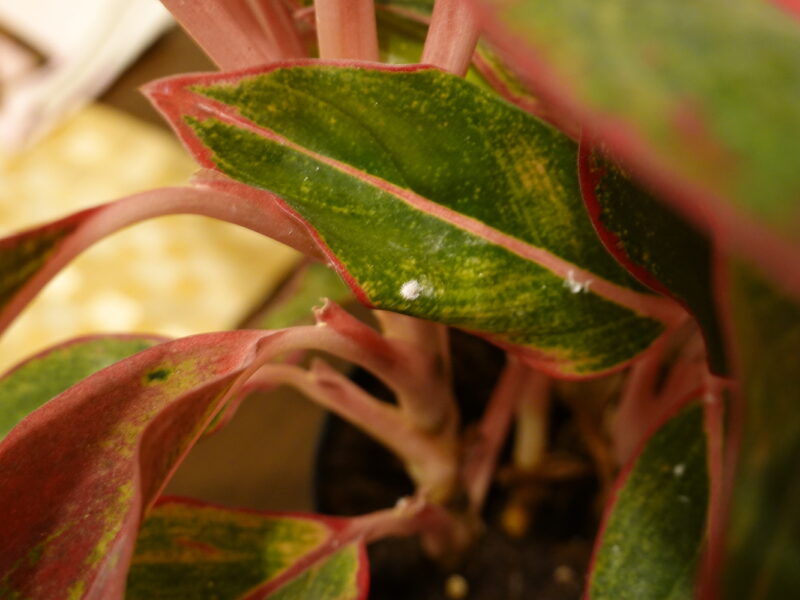

Yes, I have a severe case of cabin fever. I want to get outside, get dirty and have dirt under my fingernails. But Mother Nature has other ideas. Upstate my gardens are under a foot of snow and ice, and out here on the East End the nearly daily freezing and thawing of the soil without snow cover is surely playing havoc on late planted perennials. But I did get dirty working on my paltry few houseplants and in the process made an unfortunate discovery. It’s time for the February ramble.
Back in December I wrote about a houseplant that I’d bought at a garden center. It was expensive, nearly $30 for a 1-foot-tall Aglaonema “Siam Aurora” tricolor. It was my first ever Aglaonema (Chinese evergreen) and I was just blown away by the foliage colors. It sits on our kitchen table as its light requirements are low, and while it hasn’t grown it has held its color with no leaf shed. So far, very good.
My biggest complaint about this plant is that the stippling in the foliage makes it look like it’s got a perpetual case of twospotted spider mites, but it doesn’t. A small price to pay for a plant that adds color and life to an otherwise barren tabletop. But as it’s a new plant, I’m obsessive in inspecting the foliage for any signs of insects that hitched a ride from the grower or retailer. Not a thing. At least not until last week.
On one of my inspections I spied a small speck of what appeared to be cottony filaments. I grabbed a magnifying glass and, sure enough, it was a young mealy bug. Unfortunately, there is never just one of these, and my inspections had paid off. A more careful inspection showed more of the immature creatures, and I went into the bathroom to get my emergency kit: a cotton swab (Q-tip) and a bottle of alcohol. The swab is dipped into the alcohol and the mealybug rolled onto the swab, where it dies.
What follows after such a discovery is inspections every few days of each leaf and stem. Young mealybugs are crawlers and not white while the adults look like pieces of cotton but with short white, very thin hair-like appendages. Every single one needs to be removed, and since they can survive in every crack and crevice, the inspections and removals have to continue for months to come. I still like the plant, but somewhere along the line the grower or retailer screwed up. In the store the plants were placed next to each other with foliage touching. Young mealybugs could have simply walked from one leaf to another. But it’s more likely they came right from the original grower. It happens. You need to be alert.
I finished all my plant and seed orders last week. I ordered a single plant from Plant Delights to trial and received an email back that it was ready to ship. Maybe a new person took the order or just wasn’t paying attention so I gave them a ring to remind them that the plant was being shipped to my zone 5 address where the ground is often frozen well into May. Oops. The ship date was changed to early May, but it’s a reminder that when ordering live plants you should confirm that your order is being shipped when you think it’s appropriate, not when it’s convenient or mistakenly set up for delivery much too early in the season.
The Hamptons are well known for many things, and among them are the miles and miles of privet hedges. There are some privet issues, and some property owners and landscapers try various alternatives. Well, I got an email from a vendor today with the title “No More Boring Hedges.” Cool, what do they suggest? Hydrangeas. No, NO, NO.
Many East End gardens have great displays of hydrangeas, but most of the ones that survive are not subjected to salt spray and are in some way protected from our large four-legged rodents known as deer. Deer will eat the stems and are not shy about pruning hydrangeas. In severe winters, deer will often browse them down to the ground. If by some miracle these shrubs get tall enough to bud, they become an even more desirable feeding treat.
The best-grown hydrangeas I’ve seen out here are in walled or fenced gardens. They are protected from deer, other than those who jump the fence and feast at will, but even rabbits will browse them. You can fence individual plants for protection and remove the fence once the plants leaf out, but I know the aesthetics of such protection doesn’t work in some Hamptons gardens. Repellents are fairly useless in severe winters. Just give this some thought before you run out to get the newest smooths, oakleafs, panicles and climbers.
And long before we contemplate the first emerging dandelion or sprig of crabgrass, Procter & Gamble introduces a new and seemingly miraculous herbicide by the name of Spruce. Nice name, nice graphic design, but misleading advertising, and for some weeds it simply won’t work.
The weed science specialist I rely on for technical issues confirmed my suspicions. In spite of the hype and promotions, this product is composed of materials that will simply burn the foliage of weeds. Some weeds, like annual ones, may be killed by this product just like they are by another product named BurnOut. And if you spray it on a perennial weed like our ubiquitous dandelion it will burn the foliage. But dandelions are perennial weeds, and in order to really kill the plant — and not just the foliage — you need an herbicide that will be translocated (moved) down to the roots. Spruce will not. Well, maybe it will if you manage to kill the foliage of the dandelions each and every time they reemerge. Good luck with that.
As for an annual weed like crabgrass, yes, this material will work in the early stages (very early) of this weed. But, if it’s in your lawn, spraying Spruce will kill the grass and only very young (one- or two-tiller stage) crabgrass plants. Remember though that once crabgrass sets seed you are doomed to having it return next year.
As the sun gets higher and the days longer I begin to change my regimen with my houseplants and begin to fertilize them. Remember that houseplants are rarely grown in an organic soil that breaks down to the point where the soil releases nutrients that the plant roots can use. There are dozens and dozens of fertilizers you can choose from, but I limit my choices to organics and this is pretty much true of my outdoor plants as well. Simply put, organics are much better for your plants than chemical based or traditional fertilizers.
Organic fertilizers are not acid based like chemical fertilizers so they rarely if ever burn the roots of plants like chemical fertilizers can. The problem with organics is that they are what we call low-analysis fertilizers. This means that the percentages of nutrients available are fairly low, but on the good side they are naturally, slowly released and will benefit any and all of your plants over time. But how do you get around the fact that they offer less nutrients than the chemical fertilizers?
I was amazed at the number of organic (liquid and granular) fertilizers that you can buy now. The shelves at my local garden center have dozens and dozens of choices, but the one thing they have in common is low analysis. But you can solve this problem on your own. Say you want to use a liquid organic fertilizer on your begonias or African violets. Both of these are flowering plants that call for the middle fertilizer number (phosphorus) to be higher as this element relates to flower development. But the fertilizer you want to use is only 1-2-1 or 2-4-2 or similar and the directions call for one tablespoon per gallon of water.
If, for example, you have a liquid organic 2-4-2 that has a label rate of 1 tablespoon per gallon of water you can simply double that rate to 2 tablespoons per gallon of water and you’ve made your fertilizer into 4-8-4 without harming the plants. However, you have effectively doubled the cost of the fertilizer, which is already around $25 a quart. Not saying don’t use this method, just be aware of the cost. There are few other choices.
And speaking of organics, don’t be fooled by potting soils that scream “ORGANIC” on the bag. I seriously doubt if any potting soil you can buy is inorganic. Most potting soils are now made from various formulations of peat, bark and other wood products.
And speaking further about organics, always look for the OMRI symbol on the organic products you buy. This is an organic certification that you can rely on as opposed to the bag or bottle simply claiming to be organic. One brand that claims to be a “Miracle” may say organic but check to make sure the bottle, jar or bag has the OMRI symbol on it. You may be in for a rude awakening. Keep growing.
 More Posts from Andrew Messinger
More Posts from Andrew Messinger